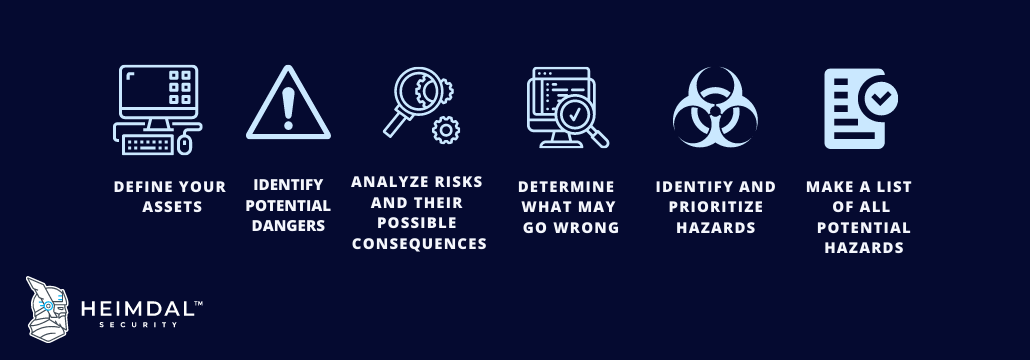Contents:
The process of detecting cyber vulnerabilities (software or hardware that might be exploited) and cyber dangers is known as cyber security risk assessment.
There are numerous advantages to doing a cybersecurity risk assessment.
Read more about the way in which a company can become more aware and prepared regarding the risks it is facing from a cybersecurity standpoint.
Why Should You Do a Cybersecurity Risk Assessment?
The only way to guarantee that the cybersecurity measures you choose are suitable for the threats your business faces is to perform a risk assessment.
Without a risk assessment to guide your cybersecurity decisions, you risk wasting time, effort, and money, as well as underestimating or overlooking hazards that might cause major harm to your business.
Cybersecurity risk assessment is a vital part of any strategy as it helps to determine the ROI of any investments and helps people better allocate their time.
Risk Assessment and Its Importance in Cybersecurity
In the digital era, cybersecurity is a growing issue for businesses. As cyberattacks become more sophisticated, it is critical for businesses to recognize the risk they are facing and take proactive measures in order to limit them.
An essential procedure for identifying and mitigating vulnerabilities in an organization’s IT infrastructure is cybersecurity risk assessment.
A cybersecurity risk assessment may be done manually by evaluating multiple sources of information or automatically by utilizing software tools.
This is an important step in securing your organization since it indicates how likely your firm is to be hacked or attacked, as well as the consequences of a hypothetical attack, and enables businesses to take precautionary measures prior to an attack in order to mitigate their cybersecurity risks as much as feasible.
A cybersecurity risk assessment evaluates the many information assets that might be impacted by a cyber-attack (such as hardware, systems, laptops, customer data, and intellectual property), as well as the numerous threats that could influence those assets.
Typically, risk estimates and appraisals are carried out, followed by the selection of controls to address the identified risks. It is critical to continuously monitor and assess the risk environment in order to identify changes in the organization’s context and to keep an overview of the whole risk management process.
Depending on the results of the assessments, the cybersecurity risk assessment report may contain a variety of items.
Once the cyber risk assessments have been completed, the cybersecurity risk assessment report will be used. A complete cybersecurity risk assessment report must back the management’s judgments. The report should identify the risks and assets associated with them, as well as the probability of occurrence and any proposed measures.
How to Recognize Cybersecurity Risks
Define your assets
You can’t safeguard what you don’t know, therefore the next step is to identify and compile an inventory of all physical and logical assets covered by the risk assessment. When identifying assets, it is critical to identify not only those assets critical to the business and likely the primary target of attackers, but also the assets that attackers would like to gain control of, such as an Active Directory server or picture archive and communications systems, to use as a pivot point to expand an attack.
Identify potential dangers
Threats are the strategies, techniques, and procedures used by threat actors to do damage to an organization’s assets. Use a threat library like the MITRE ATT&CK Knowledge Base to help identify possible threats to each asset.
Determine what may go wrong
This assignment entails defining the effects of a known threat exploiting a vulnerability to attack an asset in scope.
By summarizing this information in simple scenarios all stakeholders may better understand the risks they face in connection to critical business goals, and security teams can identify relevant actions and best practices to mitigate the risk.
Analyze risks and their possible consequences
Assess the possibility of the risk scenarios, as well as the effect on the company if they do happen. It’s important to understand that the impact of a risk occurring can have a legal, financial and reputational impact.
Risk likelihood should be established in a cybersecurity risk assessment based on the discoverability, exploitability, and repeatability of threats and vulnerabilities rather than previous events.

Identify and prioritize hazards
Each risk scenario may be categorized using a risk matrix with a risk level of “Likelihood X Impact.”
Any scenario that exceeds the agreed-upon tolerance threshold should be prioritized for treatment in order to bring it within the risk tolerance level of the company.
There are three options for doing this:
- Mitigate. Implement security controls and other steps to lower the Likelihood and/or Impact, and hence the risk level.
- Transfer. Share some of the risks with others by purchasing cyber insurance or outsourcing some processes to other parties.
- Accept. If the danger surpasses the advantages, stopping an activity may be the wisest course of action if it means not being exposed to it any longer.
However, no system or environment can be made completely safe, thus there will always be some danger. This is known as residual risk, and it must be publicly embraced as part of the organization’s cybersecurity plan by top stakeholders.
Make a list of all potential hazards
All detected risk scenarios should be documented in a risk register. This should be evaluated and updated on a regular basis to ensure that management is constantly aware of the company’s cybersecurity concerns. It should contain the following:
- The risk scenario
- Date of identification
- Existing security safeguards
- The current degree of risk
- Treatment plan – the actions and schedule for reducing the risk to an appropriate risk tolerance level.
- Progress status – the stage at which the treatment plan is being implemented.
- Residual risk is the risk level that remains after the treatment plan has been executed.
- Risk owner – the person or group in charge of ensuring that residual risks stay within the tolerance limit.
Wrapping Up
Threat prevention is critical to your organization’s cybersecurity because it is an efficient approach to building numerous levels of proactive defense.
As cyber attackers get more sophisticated, so should the methods we deploy to combat them. This is where Heimdal comes into play.
To keep its assets well protected, a company should have the proper tools in place. Take for instance our Heimdal Threat Prevention, a DNS traffic filtering tool and a product that works on emergent and hidden threats identification. Heimdal’s security suite encompasses many more efficient products focused on different areas like ransomware encryption protection, patch management, or email security.
If you’re ready to take your digital defense to the next level, you can always contact us or book a demo to schedule a free consultation with one of our security specialists.
If you liked this article, follow us on LinkedIn, Twitter, Facebook, Youtube, and Instagram for more cybersecurity news and topics.










 Network Security
Network Security
 Vulnerability Management
Vulnerability Management
 Privileged Access Management
Privileged Access Management  Endpoint Security
Endpoint Security
 Threat Hunting
Threat Hunting
 Unified Endpoint Management
Unified Endpoint Management
 Email & Collaboration Security
Email & Collaboration Security








